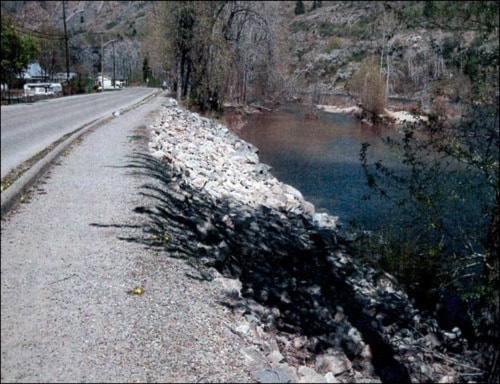The report on the City of Grand Forks’ dike system, recently sent to the Ministry of Forests, Lands and Natural Resource Operations (MFLNRO), was a positive one.
Sasha Bird, city manager of development and engineering, reported that there was no evidence of deterioration, seepage, erosion or any other difficulty with either the dike or flood gates – inspections were carried out on April 30 and May 3.
The only item that required further comment was the amount of vegetation that grows on or near the dike, in particular trees, whose roots might have a negative impact.
Bird said she didn’t think trees were a huge issue as there were trees in many areas along the riverbank.
“They’re probably keeping the bank intact because they’ve been there for so long,” she told the Gazette. “For the dike inspection, basically, all the diking authority wants to know is that the integrity of the dike is maintained at all times.
In her report, Bird indicated that no harm has been done by any of the young or mature trees, but that all are monitored annually and pruned or eliminated when necessary. “It is felt,” Bird said in the report, “That removal of these trees and the associated root systems would cause more damage to the dike than dealing with the individual issues when they arise.”
The city manager of development and engineering said that there were large portions of the dike with trees that were on private property but it was not in the city’s jurisdiction to enter on to private property and maintain it.
“We don’t look after private stuff, it would have to be up to the individual homeowners to take care of that,” she said.
Based on the inspection, however, Bird said the dike seemed sound.
“It all looks pretty good. We’ve done that section along Riverside Drive – we rip rapped (in 2008) to secure it and we also did that section along the trail by the community garden (in 2010) – we re-armoured that and the rest of it is pretty intact and pretty stable,” she said.
Bird said that the dike looks like it could withstand high water, which has been known to occur in the spring.
“It’s been doing pretty good so far. Along the river where there is no dike per se, the high water has caused erosion and that’s probably because of change in flow patterns and that’s kind of why we did that armouring by the community gardens. Because the river changed course and we had a (20 metre) right of way there and we lost (20 metres) plus a bit more,” she said.
“That’s going to happen but the dike itself, I don’t think high water will affect it at all,” she said. “If we did have an extremely high water situation, that would be the time that we would definitely find out how the dike stands up.”
Also, Bird said the city completes inspections using standards and guidelines described in the documents published by the provincial government. “We submit a compulsory report of inspections to the Office of the Inspector of the Dikes, who then assesses the adequacy of our maintenance program and the safety of the dikes,” she went on to say.
– With files from Jim Holtz
